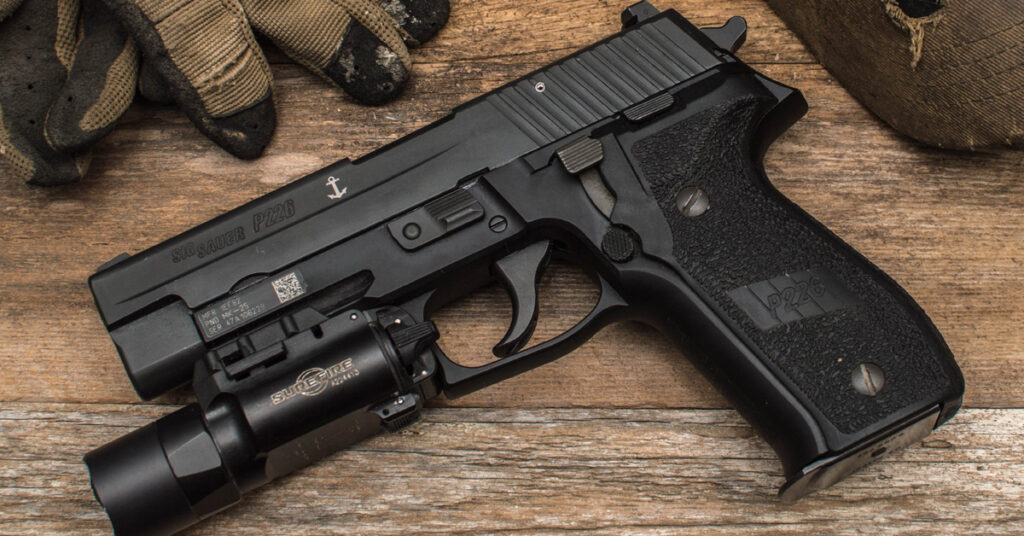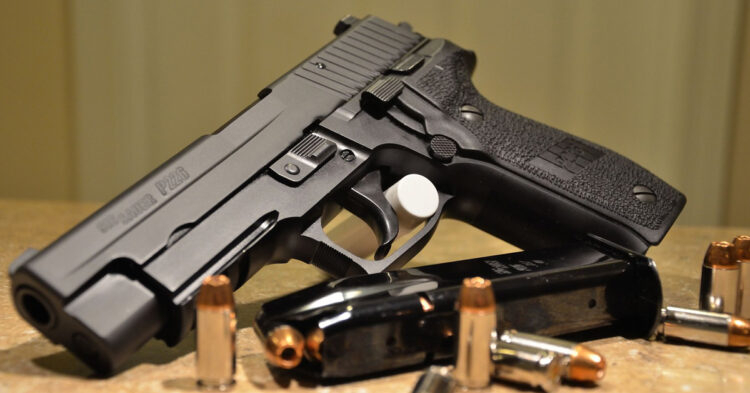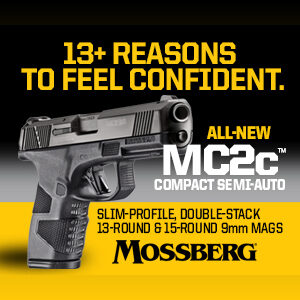CONSIDERED BY MANY TO BE THE BEST OF THE 9MM
DOUBLE-ACTION PISTOLS
The SIG-Sauer p226 – The P226 introduced a hammer-lowering system that considerably simplified the operation of double-action auto pistols. While not the first of such pistols made by the company, it was the first to introduce the concept to American shooters.
The pistol was enthusiastically received in the U.S. by both civilians and law enforcement, many of whom claim that it is one of the best of the modern high-capacity auto loaders.
HISTORY AND DEVELOPMENT
The P226 is a high-magazine-capacity version of the earlier SIG Model P220 that first appeared in 1976. The P220 was developed as SIG’s first double-action pistol and was adopted
by the Swiss army.
The P225 was a more compact version of the 220 and was one of the pistols authorized by the West German government for use by the various police forces of that country.
One of the P220/225’s most significant features was the replacement of the Walther-style hammer-dropping safety with a frame-mounted lever that simply and safely lowered the hammer when depressed. The advantage of this system was that it simplified the pistol’s operation.
With the conventional hammer-lowering safety, the pistol was deactivated until such time as the safety was disengaged. It was reasoned that in the stress of combat, an officer may forget to deactivate the safety.
With these SIG pistols, lowering the hammer did not deactivate the pistol but simply put the pistol in a first-shot double-action mode. As this required a long heavy pull on the trigger, it was reasoned that a safety was not needed.
The pistols also employed a number of state-of-the-art manufacturing methods intended to keep costs down. These included the use of high quality metal forming technology to fabricate many components that are usually machine forged.
While the pistol was very well received in Europe, it did not really create much interest in the United States, even though it was later chambered for 45 ACP and 38 Super cartridges.
American interest only began when the P226 appeared in the 1980s.
The P226 was developed to compete in the U.S. military trials for a new service pistol. While basic design and caliber was unchanged, the pistol had a high-capacity 15-shot magazine and a button-style magazine catch in the favored position behind the trigger.
The P226 performed very well in the trials, only to lose out to the Beretta 92 by a narrow margin.
This, combined with an increased demand for high-capacity double-action 9mm pistols, boded well
for the P226. Consequently, it did extremely well in the commercial and law enforcement markets.

DESIGN CHARACTERISTICS AND FEATURES
The P226 was a locked-breech double-action semiautomatic pistol. It employed the Browning cam-operated tilting-barrel locking system to lock the action after firing.
To reduce weight, the pistol had an aluminum frame with the barrel and slide made of steel. There was a
steel locking block within the slide.
Its purpose was to engage the barrel cam and prevent wear to the softer aluminum frame.
The slide was formed from thick steel plate that was then welded and machined.
This was so well done it gave the impression of being a totally machined component. The firing pin mechanism was contained within a forged steel block that was secured to the slide by means of a cross pin.
The controls were all on the left side and included a takedown latch, magazine catch, a slide stop and a decocking lever that was connected to a double-action lock. Depressing this lever safely lowered the hammer when cocked to put the pistol in the double-action mode.
While there was no external safety catch, there was a passive firing pin lock that blocked the same until the trigger was properly cycled. The de-cocking system was very similar to that of an earlier Sauer pistol, the Model 38H, although it differed in that it could not cock the hammer when at rest as could be done with the 38H.
The pistol had fixed low-profile sights that had a ramped post with a white dot and rear sight notch with a white bar at the bottom for low light shooting. The grips were made of a black plastic material
that covered the backstrap.
The P226 was simple to field strip for cleaning. The slide is locked back on an empty magazine and the takedown lever is rotated down. This releases the slide/barrel assembly, allowing it to be taken off the frame.
ASSOCIATED MODELS AND VARIATIONS
As the demand for the P226 grew, SIG-Sauer introduced a number of new models. Among the first of these was a more compact version with a shortened barrel and slide called the P228. It was followed shortly by the P229, which was identical except for its caliber of 40 S&W and the fact its slide was
machined from stainless steel instead of being fabricated from steel plate. The slide had a matte black finish and was made in SIG-Sauer’s U.S. facility. The rest of the pistol including the frame was manufactured in Germany.
As some police departments showed an interest in double-action-only pistols, additional versions of the P226 and the P228/9 were offered with this feature. The P239 was an even more compact version with a single-column seven-shot magazine intended for shooters with small hands.
In the last years of the century, the Sig Pro and the P245 Compact appeared. The former is similar to the P226 except that it has a polymer frame. The latter pistol is considerably reduced in size and, as its name implies, is a very compact version of the P226, but chambered for the 45 ACP cartridge.
Generally, the overall design of the P226 has been so sound that there have been very few changes or modifications.
Barrel lengths have only changed with the models already described, while grips and finish have remained basically unchanged. The standard grips are a molded black plastic with a roughened surface with more fancy wood grips being offered as an option or for presentation models. The standard finish is matte black oxide for steel parts with a matching black anodizing applied to the aluminum frame.
Some two-tone pistols with matte silver stainless slides and black frames have been made, while an all stainless steel model was recently added to the line.
The P226 and most of its variants remain in production at the time of writing and are still popular with
shooters who demand a reliable pistol of very high quality.
FIELD-STRIPPING THE P226
After removing the magazine and pulling back the slide to ensure that the chamber is unloaded, lock it open using the slide stop. Then rotate the takedown latch down. The slide can now be removed forward off the frame.
With slide removed, take out the recoil spring assembly followed by the barrel. This completes the field-stripping. The pistol is assembled in reverse order.
SHOOTING AND HANDLING THE P226
This is such an excellent pistol that there is very little negative than can be said about it. All the ones I have handled and shot have been very well made and absolutely reliable as well as being simple and easy to operate.
The pistol’s grip provides a comfortable hold for my hand, although it may be a bit of a handful for those with small hands and short fingers. Recoil is mild and easy to control when shooting fast multi-shot strings.
The controls are well positioned for easy access without having to alter one’s grip on the pistol.
I have always found the pistol to have above-average accuracy. The sights are prominent and easy to acquire quickly and the pistol has a very good single-action pull.
The double-action pull is equally good, having a relatively light, smooth, even, short stroke, which is achieved by the fact the de-cocking lever lowers the hammer to what is in effect an almost pre-cocked position, thus reducing the distance it has to be cocked before the point of release.
Having personally experienced times when I have forgotten to disengage the safety of some conventional double-action pistols, I particularly like the simplicity of operation that the de-cocking lever provides.
After shooting a P226, it is easy to understand why it is so popular.
COLLECTOR INTEREST
The P226 is of such recent manufacture that it does not qualify as a collector item. The pistol was always a high-priced handgun and the prices of used pistols do not exceed that of the new models of today.




You must Register or Login to post a comment